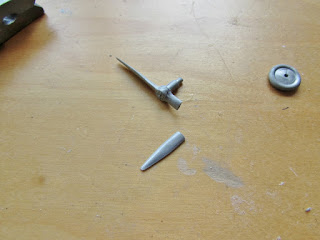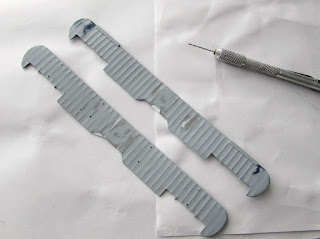http://wingsofintent.blogspot.com/2017/02/172nd-houston-westland-g-acaz-everest.html
The other plane of the expedition, G-ACBR is here:
http://wingsofintent.blogspot.com/2016/08/everest-expedition-westland-pv-3-pv-6.html
This post will depict the modification of the same molds to obtain the other Everest plane, G-ACAZ.
I have seen quite a few of "G-ACAZ" modeled, but unfortunately without modifying the kit (or incorporating just one of the many needed modifications) and therefore not really accurate, although very nice models in some cases.
The main modification needed are:
G-ACAZ:
-Different landing gear
-No elevator or rudder trim tabs
-Fin/rudder with paint outline
-No wingtip skids
-Different wing tip and ailerons arrangement
-Completely different dihedral and wing sections
-Different strut locations
-An additional diagonal strut between the inner wing struts
-Absence of little cutout inside the large wing cutout above the pilot's head
-The lower wing cutout meets diagonally the fuselage, instead of meeting a straight short section as in G-ACBR
-There were no "zippers" on the fuselage sides of G-ACAZ.
-A small rectangular opening or window is seen on the fuselage side aft of the lower wing
-G-ACBR and G-ACAZ have different small "gizmos" on the center section of the top wing
there are many other small details. Look at photos.
This second kit is an "Air Lines" very old release.
The side of the box shows the correct airplane, though. Go figure:
This outfit seems to have been associated with Testor:
The mold is exactly the same as Frog, Novo, Maquette, etc, but this "Air Lines" release has a much harder plastic, very brittle, and plagued with sink holes. See the difference between the Novo (white) and Air Lines (silver). Nothing you can't deal with, but my advise is that you steer if you can towards the Novo/Maquette releases. I got a couple of these Air Lines kits for a lower than usual price, but will have to work a little more. I purchased two Air Lines kits, the silver has extremely brittle plastic, to the point of really hindering work, the blue is just a little harder than the Novo/Maquette relaeases:
The wings are scored on the top surface and carefully "cracked" down to eliminate the dihedral. You may use a thin saw if that works better for you, but keeping straight and clean (on hindsight -and from experience- do all the surface work -sinkholes, new strut locations, wingtips, et.- BEFORE re-doing the dihedral, because the sanding work will stress those dihedral joints):
Once the new strut location holes have been drilled, the wings are scored underneath the inner struts' station and again "cracked", this time upwards to obtain the necessary dihedral at the prescribed places (inner struts). The old struts holes need to be filled on both wings. The new holes on the lower wing should go through, as they will also support the new undercarriage legs:
I was sanding the prop when it snapped, even unprovoked:
The culprit: an air bubble:The tabs have been removed from the elevators and rudder. Other parts were cleaned-up:
The fuselage sides are masked and their sinkholes puttied:
The wingtip skids are discarded and so are the landing gear parts, since G-ACAZ had a different arrangement:
Thew wings tips are now cut off:
The areas on the trailing edges of the wings that need filling are dealt with, the fuselage sides sinkholes that were puttied are now sanded:A donor kit (sorry Diego, I had to sacrifice one kit so another could live -Diego thinks this a sacrilege punished by having to endure a Puget Sound Irregulars Meeting-) provides the wingtips which were cut from the midsections using a plan template. The ailerons are also cut to size:
The wingtips are glued:
All bits in place, now for the filling, priming and sanding (the ailerons are not glued). By the way, it's better to start this way to modify the wings, adding the wingtips and filling bits and tidying-up, and then crack the wings for the dihedral, since this wingtip operation may cause some stresses that may snap the modified dihedral:
The not-so-exciting task of filling and sanding those sinkholes and other blemishes starts. More unnecessary holes are plugged with heat-stretched styrene (in this case the landing gear rear legs that are now on the wing):
The interior of this twin plane is also cleaned-up and will be given some detail, but in this case the aft position is going to be closed, so no need here of radios and such as in the other model:
Work progresses:
The holes for the landing gear fore legs are plugged and a cutout is made for the photography window:
The modified wings are primed to reveal imperfections:
New landing parts:
The two small fuselage windows located after the wing trailing edge are carved:
As with the G-ACBR model, the nose (exhaust collector) of the kit's engine is removed to be later applied to an aftermarket item. The single "pipe" going to the cylinders' heads is inaccurate, since the Bristol Pegasus had two per cylinder:
The primer revealed many areas that needed a second pass:
White primer is applied before the color coat:
The rib demarcations that were dulled during filling and sanding are put back in place using tape and primer:
The rib demarcations will only now need a very gentle swipe with a soft nail polishing stick:
The cockpit interiors for both models advance a bit with more details:
A Bristol Pegasus engines, this time from Engines & Things from Canada, was purchased. A somewhat simpler and more affordable approach then the aftermarket engine for sister model G-ACBR. Both work:
Once more the front of the kit's engine was excised and supplemented with a styrene ring:
Once in position the eighteen exhaust pipes that connect the cylinders and collector will be added:
The process of completing the interior goes on. As said, G-ACAZ will have the "cabin" doors closed, although a degree of detail will be provided anyway:
Some more detailing and painting ensues:
The instrument panel had a metal background, so the home-made part is painted accordingly. A decal of the photo of the actual panel is printed on clear stock, to be later applied:
The fuselage halves are glued together.
A dry run of the engine (made a notch in the fus. to clear the carburetor) now with its exhausts -made of thick solder wire shaped to resemble the original- is performed to check fit and clearance:
The engine is painted black:
Then dry-brushed with metal and copper tones:In front is the Engines & Things product, in the back the Radial Engines & Wheels one (for sister model G-ACBR).
The former is about half the price and a tad less detailed. The latter needs the intake pipes added on the back of the engine. Both work, depending on what you want. Both need the whole engine front exhaust pipes, collector ring and the larger exhaust stacks made and added to them:
The fuselage is now closed:
The sub-assemblies:
Control horns are added, and holes are drilled for the control cables:
A not-so-glamorous stage: puttying and sanding:
After sanding the putty, the observer's clear cover was tried, and it was found that the with of the part noticeably exceeds that of the fuselage's, by about 1 millimeter. This was also found for the part on G-ACBR. Instead of sanding the part and then having to restore its clarity, I tried pressing ever slightly the part with a clamp and dripping on it almost boiling water for about 10 seconds. Gradually the part softened and the width was reduced, so after four times the fit was good. The part did not lose clarity or deformed, but I don't recommend this, because there is danger of being scalded and the part may break or deform:
The clear part is glued to the fuselage. The other model I am making, G-ACBR, will have the hatch opened:
The windows and portholes are masked:
Fuselage stuffed, plugged and ready to for priming, together with other projects:
Primer on:
Wing and stab in place. Notice different wing root, aileron and wing tip, besides different dihedral, all needed for this version:
Landing gear in place (notice this is the scratched LG, tailored for G-ACAZ, not the kit's):
The decals from Mika Jernfors of Arctic Decals arrived, and they look great:
Metal horns are inserted in ailerons and elevators, rigging locations are drilled, and the control surfaces glued (not the vertical stabilizer, since it has an outline that had to be carefully painted). A protrusion seen in photos on the nose is added:
The mods that have to be made to G-ACAZ:
A small structure that goes after the tailskid is scratched. Noticed the single aileron control horn, double on G-ACBR:
The base aluminium color is applied:
The
windshield, which is horribly thick, it's used to vac two sets of
replacements. On the side, placed on the clothespin, the masked hatch panels for G-ACBR:
Other metal hue is applied where the metal was exposed, and also on the
after-cabin doors (will be seen from inside). The struts are airbrushed
in their color too:
The masks provided with the decal set from Arctic Decals. They cover
windshield, wheel covers, hatch portholes, fuselage top color, cabin
windows and more:
Some tidying-up and some mix trials for the fuselage top color:
Ready to proceed:
The masks from the Arctic Decals sets are applied and the deck and vertical stabilizer color is airbrushed:
The louvers visible in photos, the different oil cooler, one additional step and control cable exits are added:
Arctic Decals masks are also applied to the windshields:
Airbrushed:
A clear coat is applied and the smaller masks removed from windows and such. G-ACBR and G-ACAZ are nearing completion:
The "thermometer" struts that will replace the kit's are prepared, one for each model:
More details are added, one thing at the time:
Decaling begins, the Arctic Decals items are as usual superb, but care and patience are a must:
Another incarnation of the "thermometer strut". I'll keep this one:
The two siblings. Still quite a lot to do:
The struts are put in place on the lower wing. The windshield is added. Still to go, all the control cables and rigging on tail and wing:
Upper wing on. Some control cables in place:
To be continued.....























































































Don't understand the 'peanut butter'
ReplyDeleteinterior colour. It was a metal-framed aeroplane, with aluminium and fabric covering. The instrument panel colour was a big clue....
Regards, Roger
Dear Roger
DeleteIt is not "peanut butter", it is Argentinian "Dulce de Leche", much, much better.
Partially true: the "cabins" were partially lined with wood panels -possibly to provide further insulation against the bitter cold at 9,000 meters heights-, as these were highly modified planes, not the standard Wapiti or Wallace. But you are correct regarding the pilot area, which (again, partially) had the original metal panels.
Have a good afternoon tea.
Your friend from the across the pond
Ok....I thought you had suddenly decided it was going to be 'Willy
DeleteWonka's Wallace' :0)